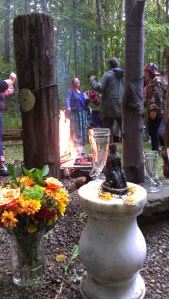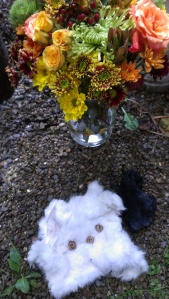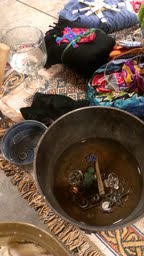I apologize for the out-of-orderness. Trying to get caught up with my dedicant requirements after a writing hiatus. Expect to see Samhain and Yule up soon as well =)
Autumnal Equinox
My third ADF rite with Stone Creed Grove
It was a soft, grey, rushed kinda day. Trying to take care of the domestic side of things before I left for Tredara was frustrating…but I did get to steal a few minutes of happiness and serenity before I showed up for ritual. Much needed and appreciated, and I arrived in a happy mood.
It was a very subdued crowd. Many had been there all weekend for ‘Aftershock’…a sort of Post-Starwood VIP party (as it was described to me), and everyone seemed to be feeling the effects of a long and happy weekend! 🙂
I continued my ‘tradition’ of crashing the nemeton set up and talking to (annoying) Klaus and Thex. But I did save the day with a well packed wine key (corkscrew) in my backpack. Yay for having open Kindred offerings! And yay for the Girl Scout motto that I repeated countless times as a child…”Be Prepared!” 🙂 I also got the chance to talk with Liafal a bit, which was really great. I will confess, strong women kinda intimidate me, and the first couple times I attended rites at Stone Creed, I was not brave enough to go talk to her…yeah I’m a shy wuss sometimes…
In the pre-ritual briefing, Ian confirmed what I’d already assumed about the holiday, that it was essentially made up – but it fit nicely in the Wheel of the Year and was a good excuse to have a get together 😉
Stone Creed Grove celebrates the ‘Minor High Days’ in the Norse tradition. The Deities of the occasion were the Vanir brother and sister, Frey and Freya.
The Earth Mother invocation honored Nerthus, a Vanir earth goddess who is entreated: “…Showering about us this day, raining sweet flowers and fruitation musky… look kindly on our work.” We also asked “Berchta, beldame of the wheel, spin us good Wyrd this day.” Berchta is said to be ‘a guardian of the beasts’ and is associated with spinning wheels and spinning.
Odin was invoked as our spirit of bardic inspiration. We asked the one eyed rune lord of wisdom to Honor our working, Waken our word skill, Quicken our magic…
Proper offering was made to the south of the grove to the Outdwellers, the unhallowed wights, etins, trolls, all of the out-garth and enemies of Asguard. A gift freely given, and a request to leave our rite untroubled, for our “hall will be well warded by red beard’s might hammer.”
The gatekeeper was Heimdall, who opened his rainbow bridge to carry our calling to all the Aesir. It was raining while we progressed to the nemeton, but the clouds cleared and the sun came out right after we opened the gates…Thank You Kindreds! 😉 After the company opened the gates, we gave offerings to the three kindreds: the Landvettir, Alfar and Disar, and Deities. Once all had received their due, we moved on to the dieties of the occasion, Frey and Freya.
The praise offerings were fewer than last rite, but very nice none the less. My favorite was a poem Talesin had written to honor Freya. I overheard Ian asking him after ritual about turning it into a song, I really hope they do! Anyway, Elizabeth also offered a really nice poem about the enveloping mists, which seemed very appropriate on that rainy day. Thexalon, Ian and Liafal also had great contributions, as always! 🙂
The Omen
Perthro: Dice cup, Merriment
Laguz: Lake, Water
Uruz: Bull, Strength













